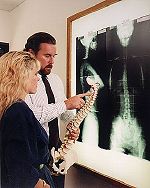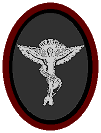| |
|
Today's
doctors of chiropractic must have at least six
years of highly specialized college training.
They must pass rigid state board examinations, and in many states
continuing education seminars must be completed for annual license renewal.
Through these measures, modern chiropractic has achieved recognition
as a comprehensive, scientifically sound force among the health professions.
Required courses of study for a chiropractic doctorate include anatomy,
physiology, pathology, chemistry, bacteriology, diagnosis, neurology,
X-ray, psychiatry, obstetrics, as well as specialized chiropractic courses.
Because
of this intense education, today's chiropractor is qualified and capable
of relieving a wider range of ailments, pain and suffering than ever
before. Included here is a comparison of basic educational requirements
for medical school graduates and doctors of chiropractic.
| Subject
|
Medical
Class Hours (Minimum) |
Chiropractic
Class Hours (Minimum) |
| Anatomy
|
508
|
520
|
| Physiology
|
326
|
420
|
| Pathology
|
401
|
205
|
| Chemistry
|
325
|
300
|
| Bacteriology
|
114
|
130
|
| Diagnosis
|
324
|
420
|
| Neurology
|
112
|
320
|
| X-ray
|
148
|
217
|
| Psychiatry
|
144
|
65
|
| Obstetrics
& Gynecology |
198
|
65
|
| Orthopedics
|
156
|
225
|
| TOTAL HOURS
|
2756
|
2887
|
Other
required subjects for the doctor of chiropractic include: spinal mechanics,
adjustive techniques and other similar basic subjects related to his
specialty. Other required subjects for the medical doctor include: pharmacology,
general surgery and other similar basic subjects related to his specialty.
This information may be valuable to others who are misinformed about
the nature of chiropractic education today. If you know someone who
could benefit from a better understanding of modern chiropractic, why
not share it with them?
|


